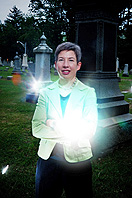News
Otto exploring use of photography
in paranormal cultures
-
 Print
Print -
 Comments
Comments
-

“Reading these movements against the grain will yield a new understanding of the interrelated nature of art, the occult and technologies of vision in the rise of modernism.”
-
In the latter part of the 19th century, a range of powerful new visual technologies were developed that used the intrinsic mechanics of light-sensitive media to achieve spiritual allusions and illusions.
Elizabeth Otto, an award-winning art historian at UB, is particularly interested in “spirit photographs” and the cultures of the paranormal as they relate to the Romantic tradition of spirit or Geist in late 19th- and early 20th-century Austria and Germany, and the rise of modernism.
Otto, assistant professor of visual studies, will pursue this investigation during the 2010-11 academic year as an Early Career Residential Fellow at the University of Pittsburgh’s Humanities Center, an honor that carries with it a $40,000 stipend and a $5,000 grant for research materials.
Her ongoing study, “Spirit/Medium: Spirit Photography and the Visual Arts in Austria and Germany, from Symbolism to the Bauhaus,” explores what she calls “the dream-like mixture of illusion and realism in art of this period.”
“New uses of photography in that era produced stereoscopic views, photograms, X-rays, cinema and alleged photos of spirits, all of which fueled a concurrent revolution in art in Germany and Austria,” she says.
“In cities like Berlin, Leipzig, Munich and Vienna, artists’ groups began to explore links between the spiritual realm and the flesh, and to reinvigorate painting, print making, sculpture, and design as modes for imagining modernity.”
They were led by the symbolists, who represented an outgrowth of the darker, gothic side of Romanticism marked by longings for transfiguration “anywhere, outside the world” and secessionist movement, dedicated to the possibilities of art outside the confines of academic tradition.
During that period, Otto says the fields of photography, Romantic philosophy and art brought together the rational and irrational to rethink the role of representation in culture.
“Photographers and artists of the period embraced the concept of ‘spirit’ and began to produce new visual forms that ‘documented’ (as in photography) and evoked (as in painting, printmaking, sculpture or design) both the previously unperceived worlds of the hereafter and a realm of universal spirituality,” she explains.
The links between the occult and technologies of vision, she notes, have wide-ranging implications for understanding the links between experimental art and science of this period and reading.
“Reading these movements against the grain,” says Otto, “will yield a new understanding of the interrelated nature of art, the occult and technologies of vision in the rise of modernism.”
Otto teaches courses on European and American art and visual culture from the 19th-century to the present, issues of gender and theory, and the history of photography.
She has been the recipient of many grants and fellowships, including a German Chancellor Award from the Alexander von Humboldt Foundation, an American Fellowship from the American Association of University Women, the Berlin Program for Advanced German and European Studies, a Deutscher Akademischer Austausch Dienst Fellowship and a Faculty Fellowship from UB’s Humanities Institute.

Reader Comments